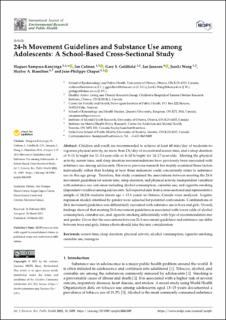24-h Movement Guidelines and Substance Use among Adolescents: A School-Based Cross-Sectional Study
Sampasa-Kanyinga, Hugues; Colman, Ian; Goldfield, Gary S.; Wang, JianLi; Hamilton, Hayley A.; Chaput, Jean-Philippe
Peer reviewed, Journal article
Published version

View/
Date
2021Metadata
Show full item recordCollections
- Artikler [5061]
- Publikasjoner fra CRIStin FHI [7531]
Original version
International Journal of Environmental Research and Public Health (IJERPH). 2021, 18 . 10.3390/ ijerph18063309Abstract
Abstract: Children and youth are recommended to achieve at least 60 min/day of moderate-tovigorous physical activity, no more than 2 h/day of recreational screen time, and a sleep duration of 9–11 h/night for 11–13-year-olds or 8–10 h/night for 14–17-year-olds. Meeting the physical activity, screen time, and sleep duration recommendations have previously been associated with substance use among adolescents. However, previous research has mainly examined these factors individually rather than looking at how these indicators could concurrently relate to substance use in this age group. Therefore, this study examined the associations between meeting the 24-h movement guidelines for screen time, sleep duration, and physical activity (independent variables) with substance use outcomes including alcohol consumption, cannabis use, and cigarette smoking (dependent variables) among adolescents. Self-reported data from a cross-sectional and representative sample of 10,236 students (mean age = 15.1 years) in Ontario, Canada were analyzed. Logistic regression models stratified by gender were adjusted for potential confounders. Combinations of 24-h movement guidelines was differentially associated with substance use in boys and girls. Overall, findings showed that meeting 24-h movement guidelines is associated with lower odds of alcohol consumption, cannabis use, and cigarette smoking differentially with type of recommendation met and gender. Given that the associations between 24-h movement guidelines and substance use differ between boys and girls, future efforts should take this into consideration. Keywords: screen time; sleep duration; physical activity; alcohol consumption; cigarette smoking; cannabis use; teenagers